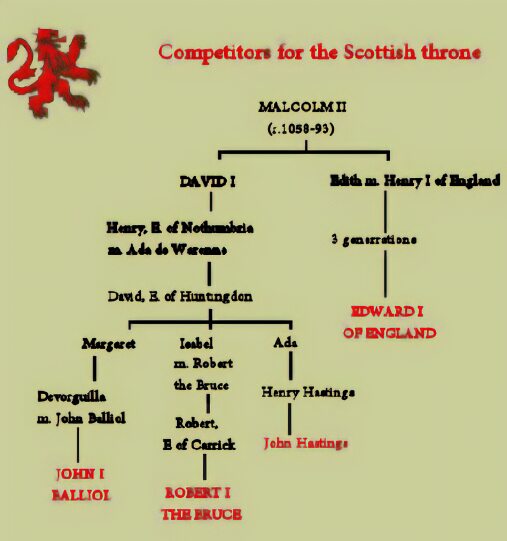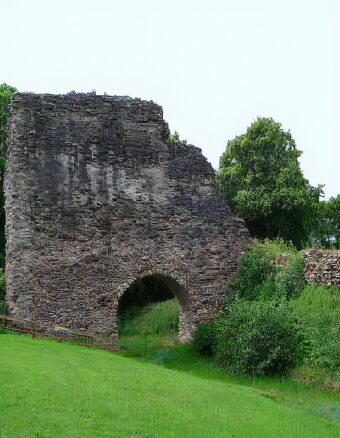Circa 1210 - 1295
Robert le Brus, 5th Lord of Annandale, was the son of Robert de Brus, 4th Lord of Annandale and Isobel of Huntingdon, the daughter David of Scotland, Earl of Huntingdon and Matilda de Kevilloc of Chester.
David, Earl of Huntingdon was himself the grandson of King David I of Scotland and his wife Matilda, Countess of Huntingdon, the daughter of Waltheof, the Anglo-Saxon Earl of Huntingdon and Northampton. The de Brus family were of Norman origin and came from Brix between Cherbourg and Valognes in Normandy. The first Robert de Brus accompanied William the Conqueror in 1066 and is thought to have died around 1094.

Robert married twice, his first wife who he married on 12 May 1240 was Lady Isabella de Clare (2 November 1226 - after 10 July 1264), the daughter of Gilbert de Clare, 4th Earl of Hertford and 5th Earl of Gloucester and Lady Isabel Marshal,their children were:-
Isabel de Brus (1249 - c. 1284), married Sir John FitzMarmaduke. Isabel was buried at Easington, County Durham.
Robert de Brus, 6th Lord of Annandale, Earl of Carrick (1253-1304) married Marjorie of Carrick and became the father of King Robert I.
William de Brus, married Elizabeth de Sully.
Sir Bernard de Bruce, of Connington, married firstly Alicia de Clare and married secondly Constance de Morleyn, and had issue.
Richard de Brus (died ca. 26 January 1287).
Constance de Brus (born 1251), married Sir William Scot de Calverley.
During the Second Barons War in England, Robert de Brus fought on the side of King Henry III and was captured at the Battle of Lewes in 1264, but was later ransomed. Following the death of Simon de Montfort, Earl of Leicester at the Battle of Evesham in 1265, Robert de Bruce was granted the estates of the rebels Walter de Fauconberg and John de Melsaand. He later accompanied Henry's eldest son, known as Lord Edward, to the Holy Land on the crusade.
Robert de Brus was appointed Regent of Scotland during the minority of his second cousin King Alexander III (1241-1286). He was the king's closest surviving male relative. Margaret of Huntingdon, elder sister of his grandmother Isabel, had only a daughter, Devorguilla, (see genealogical table above) who married John Balliol (they later became the parents of King John Balliol). Before the birth of Alexander's own children, Robert de Brus was named as his heir presumptive.
Lochmaben Castle
Alexander later produced three children, who predeceased their father. He obtained a promise from the nobles in 1284 to recognise his granddaughter Margaret, "Maid of Norway", the daughter of Erik II of Norway and Alexander's daughter, Margaret of Scotland as the heir to Scotland, who after his death succeeded to the Scottish throne. However, the seven-year-old Margaret died on the Orkney Islands on around 26 September 1290. With her death, the mainline of the House of Dunkeld became extinct and thirteen claimants asserted their rights to the Scottish Throne.
The main candidates in the line of succession were David of Huntingdon's descendants, John Balliol, Robert de Brus and John Hastings, who descended from David, Earl of Huntingdon's third daughter, Ada. In the succession dispute which inevitably followed Margaret's death, Robert pleaded tanistry and proximity of blood. He descended from the second daughter of David of Huntingdon, whereas John Balliol descended from the eldest, and thus had the lineal right. However, Robert was a second cousin of kings of Scotland and descended in 4th generation from King David I of Scotland, whereas John Balliol was a third cousin of kings and descended in 5th generation from King David I.
Robert de Brus raised a force with the aid of the Earls of Mar and Atholl and marched to Perth. The alarmed William Fraser, Bishop of St. Andrews, concerned that civil war would be the result, wrote to King Edward I of England, asking for his assistance in choosing a new king of Scotland. Edward seized the chance to demand sasine of the Scottish royal estate, but agreed to pass judgment in return for recognition of his suzerainty. The guardians of Scotland would not grant this, but de Brus paid homage to the English king. All the claimants eventually swore oaths of homage, John Balliol being the last to do so. The guardians were forced to concede on the issue.
Edward's judgment proceeded slowly. On 3 August 1291, he asked both Balliol and de Brus to select forty auditors while he chose twenty-four, to decide the case. After considering all of the arguments, in early November the court decided in favour of John Balliol, who had the superior claim in feudal law, final judgement was given by Edward on 17 November. Balliol was effectively a puppet King, set up to be manipulated by the formidable Edward and to rule Scotland according to his wishes.
John Balliol was crowned as King of Scots at Scone Abbey on 30 November 1291 and on 26 December, swore homage to Edward at Newcastle upon Tyne. Robert de Brus resigned the lordship of Annandale and his claim to the throne to his eldest son Robert de Brus.
Robert de Brus died at Lochmaben Castle in 1295 and was buried at Gisborough Priory in Cleveland
Joan of England PreviousNext The Competitors
